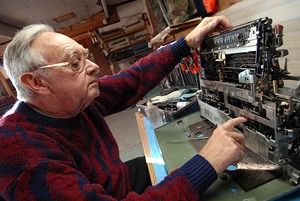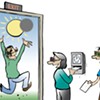Published January 9, 2008 at 12:11 p.m.
It was a typewriter with balls — literally. Before the modern miracle of the word processor, no self-respecting secretary could live without an IBM Selectric typewriter, with its revolutionary golf-ball-like, rotating typing element. Heavy-duty, state-of-the-art and putty colored, the machine’s industrial silhouette has graced millions of desks around the world. Now, thanks to the quirky TV drama “Mad Men” — about the cutthroat Madison Avenue advertising world of the 1960s — the Selectric is being introduced to a generation of text-messaging teens.
“We used them in the first episode,” says Camille Bratowski, lead set designer of the hit show, “because there was a whole gag about ‘don’t be intimidated by new technology.’”
In Vermont, no one knows more about the Selectric story than Peter Sharron, 72, who operates Peter’s Typewriter Service from his Northfield home. Sharron has fiddled with the insides of thousands of Selectrics since he went to work for IBM in 1957. He started as a clock repairman, and then switched to fixing typewriters, which he says IBM has made since the 1930s.
The first Selectrics arrived on the scene in 1961. What caused such a stir was that replaceable element ball, which came in different fonts and enabled typists to insert italic or bold type in their otherwise pedestrian “Courier”-based documents. In the hands of a good typist, the Selectric could pump out 150 words a minute. The venerable machine ruled the office roost until the mid-1980s, when daisy-wheel electronic typewriters and early word processors changed the way people tackled the printed word.
But those first daisy-wheel writers had two problems, Sharron recalls: Typists complained that there was no feel to the keyboard, and they were too quiet. “What they did was put in a thing they call a clacker, a little magnet,” he says. Every time you punched a key down, it hit the frame, and it made a little noise. It was just psychological, and that cured the problem.”
Though word processors would win out in the long run, the Selectric typewriter wouldn’t call it quits. With their aluminum bodies and mostly metal construction, the IBM machines were in for the long haul, progress be damned. “The Selectrics were made to last; I call them industrial-strength machines,” Sharron explains from his workshop, where old typewriters — mostly electrics, and mainly Selectrics of all vintages and colors — sit silently on metal shelves, relics from the days when making copies meant using carbon paper.
“I’ve worked on some in the last year that were made in probably ’64,” he offers. “These machines just won’t die.” Neither will the need for a typewriter repairman, Sharron hopes, although he is the last of his kind in the state. Rarer still is the manual typewriter, which he repairs every once in a while.
There are, however, still plenty of Selectrics out there. With a soft-spoken mien and a dry wit, Sharron speculates that a quarter of the 16 million Selectrics manufactured by IBM are still in circulation, and that 90 percent of those are still operable. “Most machines just need a good cleaning, a flushing out of certain parts, a few adjustments, and that’s it,” he explains. “[Then] it’s working, and it’s good for another 10,000 miles.”
Over the years, Sharron has extricated all manner of office detritus from beleaguered typewriters, including paper clips, staples, change, dead flies and mouse nests. “Over the weekend [the mice] would build a nest, and on Monday the machine wouldn’t start,” he surmises.
Though IBM trained Sharron how to troubleshoot and repair the machines, he remained baffled for a long time at how the individual components worked together so well. “Then one day I happened to look at it, and I said, ‘It’s nothing but a mobile,’” he recalls. “It’s like a mobile, one of those things you hang from the ceiling. Strings come down, and there are horizontal bars, and other things hang off of them. Well, that’s basically how this, the selection mechanism in the Selectric, works. There are levers in there,” he instructs, turning over a machine and pointing to the innards, which consist of more than 400 pieces. “You operate certain levers, and other levers you don’t operate,” Sharron continues. “That determines which way [the ball] turns and how much it turns. Don’t know who designed it. It’s elaborate, but it’s also simple.”
And indestructible, it seems. Over the decades some people have held onto their machines, while others have found them at rummage sales and thrift shops for as little as a few dollars. But when the Selectric I first came out, it wasn’t so cheap. As Sharron remembers, it sold for a whopping $450 — that’s $3000 in today’s money — and the elements were $15 apiece. “For $525, you had a typewriter with six different type styles,” he says.
Decades later, such massive entities as National Life and the State of Vermont still have the machines on hand, and use them regularly. At Barre’s Granite City Tool & Supply, “the girls,” says Donald Allen, the 76-year-old general manager, use typewriters for correspondence, invoices and purchase orders.
Sharron is not one to wax nostalgic for the old days, even though his repair business depends in part on those who do. He estimates he gets a half-dozen calls per month from people and businesses needing his services; he charges $75 for a basic cleaning and adjustment.
There was a certain pride in ownership with a typewriter that doesn’t exist today with computers, Sharron believes. When a secretary got a typewriter, it was hers. “Not even the boss touched it,” he asserts. “You knew if someone had been messing with your typewriter, because the margin was changed.”
The very act of typing was much more labor-intensive on the electric machines than it is today. “You had to be disciplined,” Sharron explains. “With computers, you just sit there and just type. You don’t have to worry about inserting the paper, or adjusting the paper, or taking it out, or anything else. People waste so much time sending messages to their friends in the office or typing up jokes or things like that. I think people actually work probably about 60 percent of the time now.”
One of Sharron’s customers, a high school teacher, is trying to change that. She makes a point to keep a few typewriters in her classroom among the computers, so students aren’t so quick to outsource spelling to the CPU. Sharron echoes the teacher’s concern: “With a typewriter, you had to learn how to spell. You were working with yourself, and that was that.”
More By This Author
Speaking of...
-

Dirt Road Theater Winds Its Way to a New Home in a Historic Northfield Building
Dec 13, 2023 -

Learning Curve: Northfield Newcomers Launch a Childcare Program
Sep 13, 2023 -

Good Measure Brewing’s New Pub Serves Convivial Eats in Northfield
May 2, 2023 -

Northfield’s Police Chief Takes Flak for His Provocative Public Stances
Feb 15, 2023 -

Williston Tech Company Polly Lays Off 17 People in Vermont
Dec 5, 2022 - More »
Comments
Comments are closed.
From 2014-2020, Seven Days allowed readers to comment on all stories posted on our website. While we've appreciated the suggestions and insights, right now Seven Days is prioritizing our core mission — producing high-quality, responsible local journalism — over moderating online debates between readers.
To criticize, correct or praise our reporting, please send us a letter to the editor or send us a tip. We’ll check it out and report the results.
Online comments may return when we have better tech tools for managing them. Thanks for reading.














































